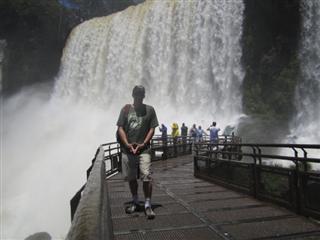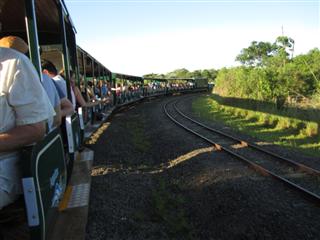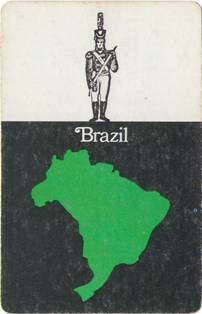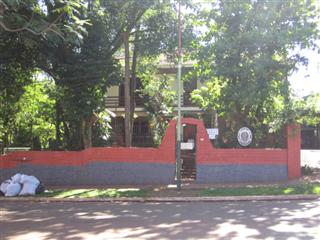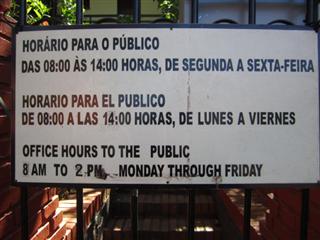Iguazu Falls
Introduction
The first time I ever saw Iguazu Falls was in the movie Moonraker. There was a boat chase during which James Bond was cornered between a pursuing boat and an enormous waterfall. Conveniently, his boat came equipped with a hang glider, which he activated just before he plummeted over the edge. You can always count on Bond to not only have exciting chases, but to have them in fabulous locales as well. For the next 25 years or so, I've waited for the opportunity to visit those falls myself. In November 2011, I finally had the chance.
Iguazu Falls lie * near the intersection of Argentina, Brazil, and Paraguay. To be specific, they are on the Iguazú River, between Argentina and Brazil, 23 kilometers upstream from the Paraná River and Paraguay. In Spanish, they are called Cataratas del Iguazú and in Portuguese, Cataratas do Iguaçu. Unfortunately, I can only tell you the experience from the Argentina side, as I'll get to later.
James Bond not withstanding, lots of people told me if I made it as far as Buenos Aires, I absolutely had to go to Iguazú Falls. There was no equivocating; if I had time for one side trip, and there are lots of side trips to take from Buenos Aires, it had to be Iguazú. Having now been there, I would have to add my name to the list of those saying that.
Getting There
The closest city to the falls on the Argentina side is Puerto Iguazú. Although it is a quiet little town, there are many daily flights from the Aeroparque airport in Buenos Aires. You can also take a 15-hour bus ride. Personally, I booked a reasonably priced air/hotel package from Travelocity.
The Puerto Iguazú airport is rather far from the city of Puerto Iguazú. However, there is a company that runs passenger vans to all the hotels. They have a desk right there at the airport. I believe the fare is 50 pesos, which is equivalent to about $12 US. A cab ride will run about 200 pesos, or $40 US.
Lodging
The hotel I chose was the Panoramic Iguazú, which I was very happy with. The hotel overlooks the Iguazú River. Brazil is right across the river, and Paraguay is easily visible about two kilometers down river. The hotel has a lovely pool, lots of garden space, a restaurant, a gift shop, and a small casino (in no small part why I chose it). It is also a short walk from the commercial section of Puerto Iguazú, which is not something you can say about many other hotels in the area, which tend to be far from both the city and the falls.
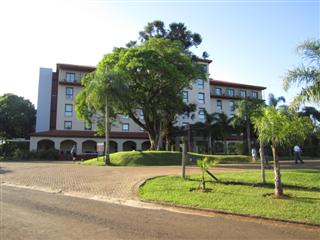 |
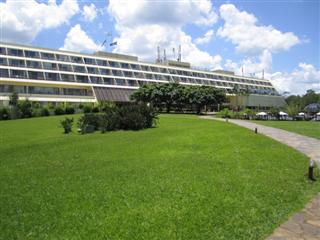 |
Two other hotels that deserve mention are the the Iguazú Grand and the Sheraton Iguazú. If you're looking for the hotel with the big casino, don't be confused as I was. It is at the Iguazú Grand, which is a bit outside of the main city of Puerto Iguazú. When I got back one of my forum members was kind enough to fill me in on the Iguazú Grand hotel and casino. The Sheraton Iguazú is the only hotel right by the falls themselves. It's within easy walking distance of the falls, and half the rooms having a direct falls view.
How to Dress
Expect to get wet if you want to get to the closest view points of the waterfalls. If you're going in the summer (Nov-Feb), also expect it to be hot. You may wish to wear a bathing suit underneath regular clothing so you can peel down to the bathing suit when you get to the wet sections. Do not wear cotton, as I did. I would recommend synthetic, fast-drying clothes, like polypropylene. Don't wear polyester, as you'll get hot and uncomfortable. In fact, don't ever wear polyester ever — anywhere. Some people purchased cheap plastic raincoats, but they looked uncomfortable and not very effective. I would not clutter up your luggage with a nice raincoat. No, a good wicking fabric is what I'd go with, which any athletic store should have plenty of.
The Falls
First let me discuss getting to the falls. There are public buses that run from the Puerto Iguazú bus station, among other places, to the Parque Nacional Iguazú (Iguazu National Park) for 10 pesos. The one I took was crowded and some people had to stand. It is about a 20 minute ride, so I would expect to pay a lot for the comfort of a taxi.
The falls themselves are in the national park, for which adults must pay an entrance fee of 40 pesos (about $9 US) . There is also a private company that does boat trips within the park, which has a stand just past the park gates. Here is a scan of their park map, which also shows the activities they offer. I'm sorry it is in Portuguese.
You should also be mindful of the park's hours. I'm afraid all I know is the close at 5 p.m., because my visit to the Devil's Throat got cut short because they ushered everybody away at that time.
As you can see from the map, there is a train with three stations. It leaves any given station every 30 minutes. Unless you are not in fit shape to walk for ten minutes, there is no reason to take the train between the first and second stops. The "green trail" will take you to the second train stop at the "central station," which leads to most of the viewpoints. Within the park, there are five trails:
Upper Circuit: This trail will take about one to two hours, depending on how much time you spend to enjoy the views. It goes along the top of lower falls. Visitors get a chance to see the water as it peacefully makes its way between islands in the Iguazú River, only to suddenly plunge over the side. This is an easy, level trail, so consequently it gets congested with a lot of elderly people.

Somewhere along the Upper Circuit trail.

Somewhere along the Lower Circuit trail.
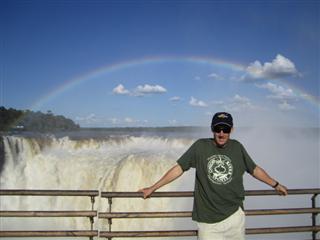 |
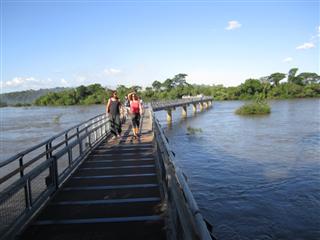 |
San Martin Island: From looking at the map, this island across the lower falls would seem to provide a magnificent view. Unfortunately, the island was closed the day I was there, due to the water level being too high.
Yacaratiá Trail: This long trail to the smaller Arrechea Fall should be a low priority. It is a nice trail in the shade of the jungle that only gets about 2% the traffic of the more popular hikes mentioned above. It also offers the best change to see wild monkeys (I saw one!). Compared to the rest of Iguazú Falls, the waterfall at the end is small, but is still very scenic and quiet, with a pool fit for swimming at the bottom.
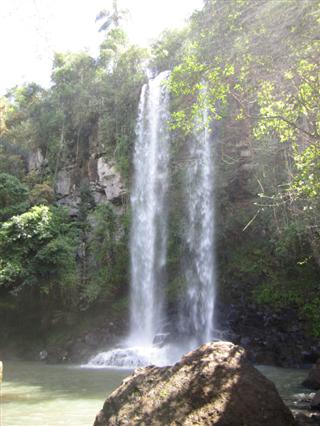
Arrechea Fall.
Map
Here is a scan of the park map. Sorry it is in Portuguese.
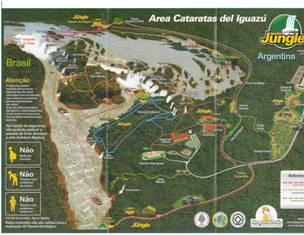 |
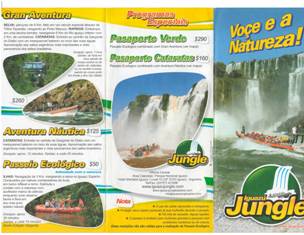 |
Animals
I've read that the jungle around Iguazu Falls are teeming with wildlife, like toucans and monkeys. What I saw was about 100 civet cats, five iguanas, and one monkey. Sorry, I couldn't get my camera out in time to get a picture of the monkey.
 |
 |
Puerto Iguazú
Considering the falls are a big tourist attraction, the nearby city of Puerto Iguazú manages to maintain its small town charm pretty well. There are lots of inexpensive restaurants, places to drop off laundry, convenience stores with Internet-connected computers and private booths to make cheap phone calls, gift shops, and bars.
In the main part of town, there are no stoplights and most streets don't have signs. The iMap feature on the iPhone is not aware of the individual streets either. Suffice it to say even with a map it is easy to get confused and lost in this little town. However, the locals are nice and seem happy to help out a befuddled Yankee. Should you like olives (I hate them), you'll be in heaven, as lots of stores seems to specialize in them, but just the green kind.
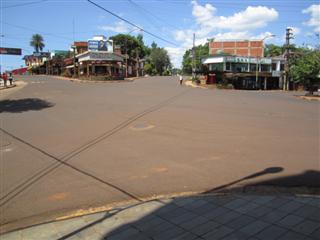 |
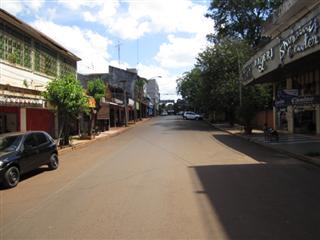 |
Left: Seven points — Right: Typical street.
One quick and fun activity is to visit the Hito Argentina, about a kilometer west of town. This observation point at the confluence of the Iguazú and Paraná rivers, directly cross from Brazil and Paraguay, boasts a dozen little stands selling souvenirs and handmade crafts. The road leading to this point along the Iguazú river makes for good jogging, with lots of park space overlooking the river.
Finally, the place is almost a ghost town between 2 pm and 4 pm, when everybody takes a siesta. I would use that time to take one yourself if you're not at the falls, because everything will be closed. Plus, if it is the summer, it will be hot.
Spanish Lesson
It seems that in Mexico and the US the preferred word for a waterfall is cascada. However, in my preparations for this trip, it seemed that Iguazu Falls was always referred to as Cataratas de Iguazú in Spanish. That leads to the question, what is the difference between a cascada and catarata? Getting at the answer was another goal of my trip.
Before leaving, I asked a number of Spanish speakers about this and everyone seemed to say they meant the same thing. As someone trying to learn a new language, this frequently given answer frustrates me. If two words mean exactly the same thing, why have two of them? Of course, English is just as bad in this respect.
So, once I got near the falls, I annoyed everyone who had the misfortune of meeting me about this issue. After bothering the whole city with this question, the consensus seems to be that a cascada is a single waterfall and cataratas refer to a whole bunch of them. Furthermore, cascada can apply to any waterfall, no matter how small. On the other hand, cataratas is not a word to be used lightly; only an impressive set of waterfalls is deserving of the term.
While I seemed to clear that up, a new question arose: individual waterfalls in Iguazu National Park were labeled as saltos. In my discussions with those speaking Mexican Spanish back home, the word salto never came up.
It was clear from context that a salto was an individual waterfall. However, that led me to question what is the difference between a cascada and a salto? Again, I bothered lots of people about this, being careful not to do so too close to any railings. Languages are not an exact science, and you never get the exact same answer twice. However, the consensus seemed to be a salto and cascada are the same thing. It is just that in Mexico they say cascada and in Argentina salto. Like how we take a vacation in the US but in England people take a holiday.
Brazil Side
I love traveling. Other than passport stamps, one way I measure my progress is by how many of the 42 territories in the game of Risk I have been to (16 so far). Before this trip, I had not been to any in South America. A major aim of this trip was to travel across the Iguazú River to explore the Brazil side, pay a visit to nearby Paraguay, and cross Brazil off my list of Risk cards.
Let me quote what my (un)trustworthy Lonely Planet guide said on the subject in a call-out box on page 225 of their book on Argentina, in the chapter on Puerto Iguazú (Argentina).
Entering Brazil: If you're on a day trip, formalities are minimal. Argentine officials will stamp your passport as you leave the country, but Brazil usually unofficially tolerates day entry (even if you need a visa) without stamping you in.
There are also lots of forums on the topic of the visa requirements for US citizens wishing to visit the Brazil side of Iguazu Falls. The general consensus on these forums lines up with what Lonely Planet says. I've read comments that the authorities on the Brazil side have special arrangements with tour companies and taxi drivers to let US visitors slip through, and that they don't even bother to stop public buses.
Let me be absolutely clear with what I'm about to say: Lonely Planet and all this chatter on the Iguazu forums is WRONG! Maybe it used to be right, but it was not as of November 2011.
My plan was to do the Argentina side on Friday and the Brazil side on Saturday. So Saturday morning, I asked a cab driver about taking me into Brazil. He said without a visa it is impossible for US citizens and I was taking a huge chance by even trying. He said I'd also be putting him in a tough spot since he could get arrested for tráfico de humanos (human trafficing). That wasn't encouraging, but I wasn't going to take one "no" for an answer after everything I had read.
So I made my way to the bus station, where there are lots of travel agencies and tour companies. 100% of everybody I asked said Brazil is very strict at the bridge between the two countries and just attempting to cross without a visa could mean anywhere from paying a hefty fine to being arrested. This was pretty much certain for me and possible for whomever drove me. I'm told you can't walk across the bridge. After the whole incident with the American hikers who allegedly wandered into Iran, I wasn't in the mood to take any chances.
The only possibility was to visit the consulate of Brazil in town and pay for a legitimate visa. It was a bit hard to find with what few street signs exist in Puerto Iguazu, but eventually I located it. However, it was a Saturday and it was closed. Even if it were open, I'm not sure if they issue visas on short notice.
When I got back, I told this story to a friend who is a dual citizen of the US and Argentina. She said when she was in Iguazú in 2006 she tried to cross with only her US passport. She tried to explain how she lost her Argentine passport, in perfect Spanish with an Argentine accent, but the authorities had none of it and sent her back.
So, not only was my mission to set foot in Brazil a failure, but I wasted a whole morning learning what I just told you. To add insult to injury, when I was on the plane back to Buenos Aires the next day, the guy in the next seat was playing Risk on his iPad. What are the odds?
What I have read and been told is the Brazil side has viewing points that give an outstanding panorama of all the falls. However, you don't get right up next to them, as you do on the Argentina side. The Brazil side is also small, without the many miles of walking paths they have in Argentina. I've read a couple hours is all you need to experience the falls from Brazil. I can't vouch for all this directly, so take that with a grain of salt.
Video
Here is a video I made from various spots around the falls. Sorry for the parts where the camera is sideways. Here is the order of the footage: 1. Upper circuit trail. 2. Lower circuit trail and boat ride. 3. Macuco Trail. 4. Devil's Throat.
Conclusion
Iguazu Falls is definitely a worthy excursion if you're going to Argentina anyway. If you want to visit the Brazil side, I would get your visa in advance. This will cost $140 (source) plus another $75 or so for a service to help you get it. You'll have to ask yourself it is worth the time and bother. Since I didn't make it to there, I can't help with the answer to that question.
I think one solid day is enough to experience the falls from the Argentina side. Two days would allow you to really do everything and take your time.
Footnote
When I solicited comments about this article on my Wizard of Vegas forum a big debate erupted about the correct word in this sentence, Iguazu Falls (lie/lies/lay) near the intersection of Argentina, Brazil, and Paraguay. I finally decided to go with "lie," against the advice of my proofreader.
Other Pages from the Wizard's Argentina Trip
- Buenos Aires by the Wizard
- Casino report on Argentina and Uruguay by the Wizard
- Iguazu Grand Casino by Aluisio.





